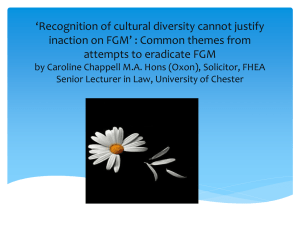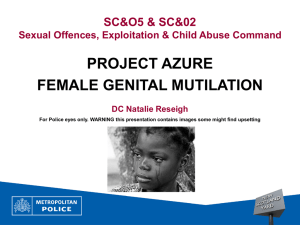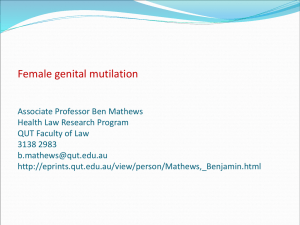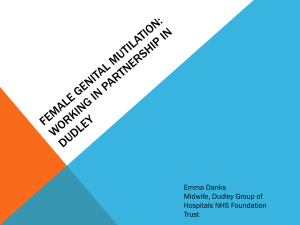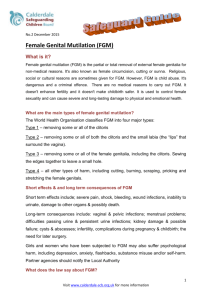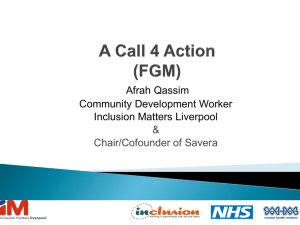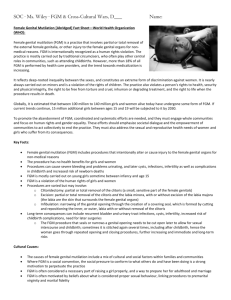advertisement
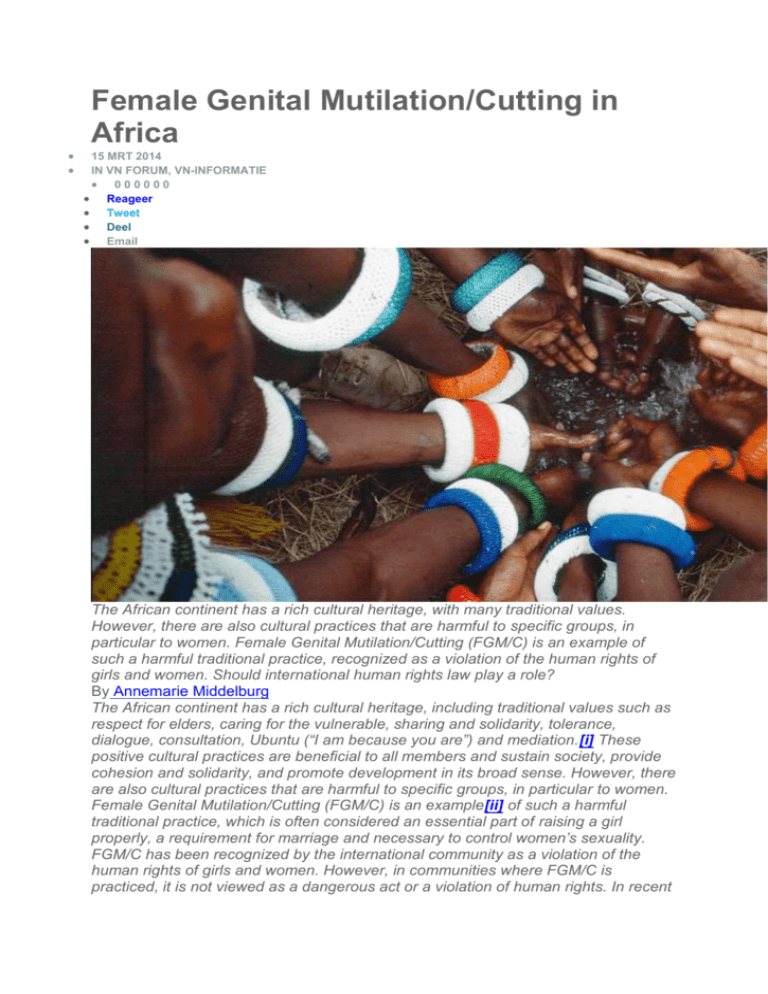
Female Genital Mutilation/Cutting in Africa 15 MRT 2014 IN VN FORUM, VN-INFORMATIE 000000 Reageer Tweet Deel Email The African continent has a rich cultural heritage, with many traditional values. However, there are also cultural practices that are harmful to specific groups, in particular to women. Female Genital Mutilation/Cutting (FGM/C) is an example of such a harmful traditional practice, recognized as a violation of the human rights of girls and women. Should international human rights law play a role? By Annemarie Middelburg The African continent has a rich cultural heritage, including traditional values such as respect for elders, caring for the vulnerable, sharing and solidarity, tolerance, dialogue, consultation, Ubuntu (“I am because you are”) and mediation.[i] These positive cultural practices are beneficial to all members and sustain society, provide cohesion and solidarity, and promote development in its broad sense. However, there are also cultural practices that are harmful to specific groups, in particular to women. Female Genital Mutilation/Cutting (FGM/C) is an example[ii] of such a harmful traditional practice, which is often considered an essential part of raising a girl properly, a requirement for marriage and necessary to control women’s sexuality. FGM/C has been recognized by the international community as a violation of the human rights of girls and women. However, in communities where FGM/C is practiced, it is not viewed as a dangerous act or a violation of human rights. In recent years, one of the most highly debated issues is the role international human rights law should play in addressing a practice that is strongly anchored in cultural beliefs and norms[iii] =-=-=-=-=-=-=-=-=-= Definition of FGM/C 1. 2. 3. 4. FGM/C is a procedure that involves partial or total removal of the external female genitalia, or other injury to the female genital organs for non-medical reasons. FGM/C is classified in four major types: Clitoridectomy: partial or total removal of the clitoris; Excision: partial or total removal of the clitoris and the labia minora, with or without excision of the labia majora; Infibulation: narrowing of the vaginal opening through the creation of a covering seal. The seal is formed by cutting and repositioning the inner, or outer, labia, with or without removal of the clitoris; All other harmful procedures to the female genitalia for non-medical purposes, e.g. pricking, piercing, incising, scraping and cauterizing the genital area. =-=-=-=-=-=-=-=-=-=-=-= Prevalence The World Health Organization (WHO) estimates that about 140 million girls and women worldwide are currently living with the consequences of FGM/C. Each year, three million girls undergo FGM/C on the African continent alone. FGM/C has been documented in 29 countries in Africa, in a few countries in Asia and the Middle East, and to a lesser extent within some immigrant communities in Europe,[ii] Australia, Canada, New Zealand and the United States. The prevalence of FGM/C varies considerably, both between and within regions and countries, with ethnicity as the most decisive factor. In the north-eastern part of Africa, prevalence ranges from 91% in Egypt to 74% in Ethiopia. In the west, 89% of women in Mali and 76% in Burkina Faso have been cut. In the south-eastern region prevalence rates are relatively lower, as represented by Kenya at 27%. The continuing strong prevalence of FGM/C in Africa is a major cause of concern of the international community. [i] [iii] Consequences FGM/C is performed on girls and women at varying ages. The procedure is mostly carried out on young girls between infancy and age 15, and occasionally on adult women, depending on the community or ethnic group that practice it. FGM/C is usually carried out by traditional circumcisers, without anesthesia, using a knife, scissors, razor blades or broken glass. FGM/C is increasingly being performed by medical professionals (whether in a public or a private clinic, at home or elsewhere) rather than by traditional practitioners.[iv] However, medicalization of the practice does not in any way make FGM/C more acceptable. The practice has no health benefits, and it harms the health and lives of girls and women in many ways. Immediate complications can include severe pain, shock, haemorrhage (bleeding), tetanus or sepsis (bacterial infection), urine retention, open sores in the genital region and injury to nearby genital tissue. Death can be caused by haemorrhage or infections, including tetanus and shock. Long-term health consequences can include recurrent bladder and urinary tract infections, cysts, infertility and an increased risk of childbirth complications and newborn deaths. Women who have undergone FGM/C are subjected to a significantly greater risk of requiring caesarean section and suffering more post-partum as compared with women who have not been cut. FGM/C can also lead to negative psychological consequences. Documented effects include post-traumatic stress disorder, anxiety, depression, and psychosexual problems. [v] Cultural, religious and social causes The causes of FGM/C include a mix of cultural, religious and social factors within families and communities. One of the most common explanations is local custom with women themselves unwilling to give up the practice, which they see as a longstanding tradition passed on from generation to generation. In many places, the practice is often linked to a ritual marking of the coming of age and initiation to womanhood. Though no religious scripts prescribe the practice, practitioners often believe it has religious support. Furthermore, FGM/C is often motivated by beliefs about what is considered proper sexual behavior, linking procedures to premarital virginity and marital fidelity. FGM/C is also associated with cultural ideals of hygiene, femininity and modesty, which include the notion that girls are ‘clean’ and ‘beautiful’ after removal of body parts that are considered ‘male’ or ‘unclean’. In communities where the practice is viewed as a prerequisite for marriage and where women are largely dependent on men, economic necessity can be a determinant to undergo the procedure. It has been argued that FGM/C functions as a self-enforcing social convention and acts as a social norm wherein individuals and families in a community uphold the practice because they believe that their group or society expects them to do so; otherwise, they suffer social sanctions. Local structures of power and authority, such as community leaders, religious leaders, circumcisers, and even some medical personnel can contribute to perpetuating the practice. [vi] Global movement against Violence Against Women (VAW) It was not until the 1990s that FGM/C featured seriously on the agenda of the international community. VAW was widely viewed as a ‘private’ act or a ‘domestic matter’ that is carried out by private individuals rather than state officials. For this reason FGM/C was initially placed beyond the scope of international human rights law, but this changed in the 1990s with the global movement against VAW. Human rights violated Over the past decades, efforts of the UN to abandon FGM/C focused on the adverse health consequences of the practice. However, in recent years the international community began to realize that FGM/C is not only a health issue, but also a matter of human rights. [vii] FGM/C of any type is a violation of several human rights of girls and women. The act itself is at its essence a basic violation of girls’ and women’s right to physical integrity. FGM/C can be seen as a form of gender discrimination. The practice reflects deep-rooted inequality between the sexes, and is aimed at controlling women’s sexuality; it also carries a fundamental discriminatory belief of the subordinate role of women and girls in society. FGM/C also violates a person’s right to be free from torture and cruel, inhuman or degrading treatment, and the right to life in the most extreme cases, when the procedure results in death. It is nearly always carried out on minors and is therefore a violation of the rights of children. The human rights framework These human rights are enshrined in international and regional human rights treaties, such as the Convention on the Elimination of all Forms of Discrimination against Women (CEDAW), the Convention on the Rights of the Child (CRC), the African Charter on Human and Peoples’ Rights, the African Charter on the Rights and Welfare of the Child and the Protocol to the African Charter on Human and Peoples’ Rights on the Rights of Women in Africa (Maputo Protocol). In addition to these legally binding international treaties, soft-law instruments (such as General Assembly Resolutions, General Comments and Recommendations of treaty monitoring bodies, etc.) are also important to consider. It should be noted that states should refrain from invoking any custom, tradition or religious consideration to avoid their obligations with respect to FGM/C.[viii] Duties of states States need to criminalize FGM/C at the national level and prosecute perpetrators. In addition, states need to put in place adequate and concrete national accountability mechanisms for the implementation and monitoring of legislation and law enforcement. Apart from legislation, there is a need to adopt effective and appropriate measures aimed at preventing and abolishing FGM/C. States should develop national action plans (NAPs) and strategies to abandon FGM/C. However, it is not enough to develop laws and policies; states should have a political commitment and are urged to allocate sufficient financial resources to the implementation of policies and legislative frameworks. Appropriate educational and training programs and seminars, as well as awareness-raising campaigns should be introduced. The aim of education and public information programs is to change prevailing attitudes, and address gender roles and stereotypes that contribute to FGM/C. States are recommended to “give vigorous support” to the efforts of the non-governmental and community organizations and religious institutions at the national and local levels working for the elimination of FGM/C. The Special Rapporteur on violence against women stated that “[t]he involvement of local women’s groups and civil society in the movement to eradicate harmful practices is the only guarantee that the practice will not re emerge in the future.”[ix] Another recommendation for states is to collect and disseminate basic data about the prevalence, trends, attitudes and behavior regarding FGM/C, as well as on reported cases and enforcement of legislation. States need to establish or strengthen comprehensive and accessible sexual and reproductive health support services to respond to the needs of girls and women and to provide adequate training for health-care workers at all levels on issues raised in the context of FGM/C. States should also involve all actors with a view to promoting a collective and individual awareness of the human rights of women and girls and how harmful traditional or customary practices violate those rights. In the latest GA resolution, states are urged to “pursue a comprehensive, culturally sensitive, systematic approach that incorporates a social perspective and is based on human rights and gender-equality principles in providing education and training to families, local community leaders and members of all professions relevant to the protection and empowerment of women and girls in order to increase awareness of and commitment to the elimination of female genital mutilations.”[x] States are called upon to explore, through consultations with communities and religious and cultural groups and their leaders, alternatives to FGM/C, in particular where FGM/C is part of a ritual ceremony or rite of passage. Problems regarding implementation Most African states have signed and ratified the relevant international and regional human rights treaties. In countries where FGM/C exists, laws against FGM/C have been enacted. At the same time, even when laws prohibiting FGM/C are in place, they are “not effectively implemented in many places because of the strength of traditional attitudes, and in some cases because of the existence of religious or customary legal systems”[xi] that actually support these attitudes. Hence it is important that African states not only pay attention to the criminalization of the practice, but also to the other duties that follow from the human rights framework, as described above. It is important that African states allocate sufficient financial and human resources for the implementation of the international human rights framework aimed at abandoning FGM/C. In the past they relied too heavily on assistance of the international community (e.g. through the UNFPA-UNICEF Joint Program). Crucial in the abandonment of FGM/C is political will at the national level. What is required is that political leaders are engaged and provide political support to change the cultural practice. The Inter-African Committee on Traditional Practices Affecting the Health of Women and Children also argued that “[p]olitical will is at the centre of achieving zero tolerance to FGM”.[xii] Conclusion The relationship between legislation, human rights and positive social change manifested in the abandonment of FGM/C remains complex. History and experience has shown that law alone cannot change social behavior. Rahman and Toubia pointed out that “[s]topping the practice […] cannot be achieved by the simple act of drafting or interpreting a set of human rights principles or laws, even though such steps are necessary to enhance the process of change. To effect such profound social change, government action should take multiple forms and be part of a longterm process of guaranteeing human rights for all, particularly women and girls.”[xiii] Unfortunately, a lot remains to be done. Despite the efforts of the African states, which must be acknowledged, there still remains a gap between aspirations and values embodied in the relevant human rights instruments and the reality that FGM/C still persist in African societies. Notes [i]. Pan-African Conference on Celebrating Courage and Overcoming Harmful Traditional Practices in Africa, Report, 5-7 October 2011, AU Conference Centre, Addis Ababa, Ethiopia, Department of Social Affairs, October 2011, pp. 1 and 4.en 4. [ii]. Other harmful practices include forced feeding of women, early marriages, practices and taboos preventing women from controlling their fertility, female infanticide, succession and inheritance, wife inheritance and son preference. [iii]. ‘Female Genital Mutilation, A Matter of Human Rights, An Advocate’s Guide to Action’, Center for Reproductive Rights, New York: 2006, p. 5. [i]. WHO, Fact sheet N°241, Female genital mutilation, updated February 2013, see website WHO: http://www.who.int/mediacentre/factsheets/fs241/en/. [ii]. A. Vossole, M.J. Middelburg, C. Arnaut, E. Leye, J. Deblonde, L. Mergaert & S.O’Brien Green, Female genital mutilation in the European Union and Croatia, European Institute for Gender Equality Publications Office, 2013. [iii]. Most recent Demographic and Health Surveys (DHS) and Multiple Indicator Cluster Surveys (MICS). [iv]. See also UNAIDS, UNDP, UNFPA, UNHCR, UNICEF, UNIFEM, WHO, FIGO, ICN, IOM, MWIA, WCPT, WMA, Global strategy to stop health-care providers from performing female genital mutilation, Geneva: World Health Organization, 2010. [v]. WHO, Fact sheet N°241, op. cit. note 4. [vi]. See also: UNICEF, Changing A Harmful Social Convention: Female Genital Mutilation/Cutting, Innocenti Research Centre, Florence, 2005; UNICEF, The Dynamics of Social Change: Towards the abandonment of FGM/C in five African countries, Innocenti Research Centre, Florence, October 2010; UNICEF, Female Genital Mutilation/Cutting: A statistical overview and exploration of the dynamics of change, New York, July 2013, pp 14-21. [vii]. B. Shell-Duncan, ‘From Health to Human Rights: Female Genital Cutting and the Politics of Intervention’, American Anthropologist, Vol. 110, Issue 2, 2008, p. 227. [viii]. See e.g. GA Resolution 48/104: Declaration on the Elimination of Violence against Women, Article 4. [ix]. Report of the Special Rapporteur on violence against women, its causes and consequences (E/CN.4/2002/83), para. 113. [x]. GA Resolution 67/146 on Intensifying global efforts for the elimination of female genital mutilations, para. 10. [xi]. World Report on Violence Agaist Children, 2006, p. 74. [xii]. See http://www.ipu.org/news-e/wop/33/5.htm. [xiii]. A. Rahman & N. Toubia, Female Genital Mutilation, A Guide to Laws and Policies Worldwide, Zed Books, 2000, p. 56. Reageer Tweet Deel Email
